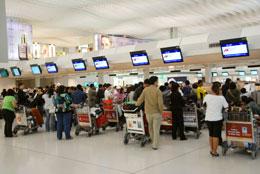One in 10 households have a OFW member

As of this year, one out of every 10 Filipino households has a member working overseas. To be precise, 10.1 percent of the household heads interviewed in three national Social Weather Surveys so far this year said Yes when asked if the household had a member working in another country.
By official projections, there are presently 22.2 million households in the Philippines. Thus, an estimated 2.2 million are OFW-households.
But the proportion of OFW-households has been falling. The SWS surveys show that the proportion of OFW-households has declined since 2009, and rose just a bit in 2015.
Schooling matters the most. Pooling together the three quarterly surveys of 2015, the average proportion of OFW-households among those headed by a college graduate is 19.8 percent (i.e., one in every five households headed by a college graduate has an OFW in it). Such households comprise 11.5 percent of all households in the Philippines, according to the SWS 2015 surveys.
In contrast, having an OFW is only 11.5 percent among households headed by a high school graduate who did not complete college, only 7.4 percent among those headed by an elementary school graduate who did not complete high school, and only 4.4 percent among those headed by someone who did not complete elementary school.
Taking averages of 2015 by area, the percentage of OFW-households is 13.7 in the Balance of Luzon, versus 9.1 in the National Capital Region, 8.3 percent in the Visayas, and 7.1 percent in Mindanao.
OFW-households are much less economically deprived. This is partly because of the remittances sent by their OFWs, and partly because they have members more capable of being employed abroad in the first place. The figures below are special tabulations of the September 2015 Social Weather Survey, comparing the economic situation of the 10.0 percent of households with OFWs to the 90.0 percent of households without them.
In September 2015, 44 percent of adults from OFW-households expected their quality of life to improve in the coming year, and 6 percent were pessimistic about it, for a Net Optimism rate of +38. In non-OFW households, 37 percent were optimistic and 5 percent were pessimistic, for a Net Optimism rate of +32.
OFW-household-people are equally satisfied with governance. In September 2015, satisfaction with the performance of the national administration was 58 percent among adults in OFW-households, versus 59 percent among other adults. The corresponding dissatisfaction rates were 25 percent and 22 percent.






